If you've ever wandered through a city and spotted tiny cell towers for 5G on street light poles. They look like little boxes however they're actually sending wireless signals from mobile providers to your phone.
These smaller towers are replacing the larger specially-designed cell towers. While they're less noticeable however, they could create issues for users.
A FCC's Radiation Exposure Thresholds
The FCC's Radiation Exposure Thresholds determine the maximum amount of time one can expose to electromagnetic energy generated by wireless devices. The limits of exposure are based on scientific data that show that RF energy could be harmful to human health.
safe distance from cell tower (SAR) is a measure of the amount of radiofrequency energy taken up by tissues. It's usually 1.6 milliwatts per kilogram calculated over one gram of tissue.
Since 5g is able to transmit at higher frequencies and has the potential to create more energy on the skin as well as other body areas. what is a safe distance from a 5g cell tower can lead to many possible harms, such as an increase in the development of skin conditions such as dermatitis, skin cancer and cataracts.
Due to the possible severe effects of 5g radiation, PSU has chosen to create a general power density limit of 4 mW/cm2 based on the average on 1cm2, and never exceeding 30 minutes for the entire 5G spectrum at 3000 GHz. This localized limit is in accordance with the peak SAR that is spatially averaged at 1.6 W/kg averaged over 1 g of tissue at 6 GHz.
The FCC's Maximum Exposure Thresholds for Maximum Exposure
If you've ever used a cell phone, you probably know that a safe location from the tower is at least 400 meters. This is because the transmitting power of a cell tower increases dramatically the farther you are from it.

Although this may sound like a good idea however, people living in close proximity to towers may actually be more susceptible to health issues. For example, a study from 2014 in India found that residents who lived within 50m of cell towers experienced significant more health issues than those living further distance from them.
But, the study found that people who moved into areas farther away from cell towers experienced their symptoms improve within a few days. https://paste1s.com/notes/KX15SJK have demonstrated that exposure to extreme levels of radiofrequency electromagnetic fields (EMFs) can cause brain tumors, cancers, and other health problems.
This is because the RF radiation utilized in wireless communications, can penetrate the human body's exterior layer, the skin. It is crucial to know since the skin functions as a protective barrier against injury to the body, infection from pathogenic microorganisms, as well as entry of toxic substances. Additionally, it is the most important organ in the human body and is accountable for keeping the integrity of other organs.
The FCC's Minimum Exposure Thresholds for the Minimum Exposure
The FCC's Minimum Exposure Thresholds are based on many assumptions that aren't supported by evidence from science. They include the incorrect belief that short-term exposures RF radiations are not harmful due to the limited penetration into the body (i.e. the heating of tissues).
This also overlooks the more extensive penetration of ELF elements of modulated radio signals and the effects of brief bursts of heat generated by RF waves that are pulsed. These theories are not compatible with current understanding of the biological effects of RF radiation. As such, they should not be considered for health protection exposure standards.
Additionally, the ICNIRP and FCC restrict its maximum levels of radiation exposure for local peak SARs, based on the maximum spatial specific absorption rate (psSAR) that is not a reliable dosimetric instrument to determine the degree of radiation exposure. In particular it is inconclusive for frequencies above 6 GHz. Additionally, psSAR hasn't been tested for RF radiation with co-exposure to other environmental agents such like sunlight. Interactions of RF radiations with different environmental agents may produce synergistic or antagonistic impacts. This could result in the risk of having adverse health adverse effects. For example, co-exposure to RF radiation and sunlight could cause an increase in the incidence of developing skin cancer and exacerbate other skin diseases such as acne.
